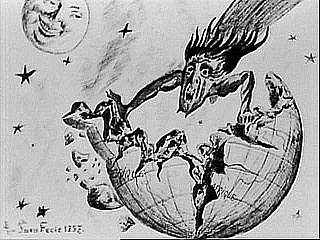 One view of comets as destroyers of worlds in 1857. (Original source unknown) |
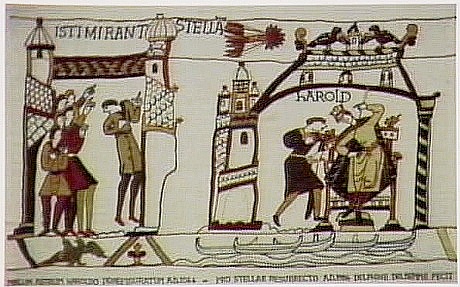 King Harold and nation cower in fear at the close passage of Halley's Comet (picture from part of the Bayeux Tapestry; more pictures at The Bayeux Tapestry Gallery). |
The passage of the comet Hale-Bopp through our part of the solar system created spectacular displays in the spring of 1997. Every newspaper, television and radio station carried some report with photos of the comet. We had a foretaste of the Hale-Bopp show when Comet Hyakutake passed close to the Earth in the spring of 1996. Hale-Bopp was one of the brightest comets to grace our skies this century, coming close to the displays put on by Comet West in 1976 and Halley's Comet in 1910. Many people were justifiably interested in Hale-Bopp---it was a gorgeous site! Many people also tuned into the news and astronomy web sites in the summer of 1994 when the comet Shoemaker-Levy 9 smashed into the planet Jupiter. Predictions of Jupiter's demise were, of course, greatly exaggerated---Jupiter took the hits in stride.
 One view of comets as destroyers of worlds in 1857. (Original source unknown) |
 King Harold and nation cower in fear at the close passage of Halley's Comet (picture from part of the Bayeux Tapestry; more pictures at The Bayeux Tapestry Gallery). |
Our favorable view of comets is a big change from the dread and fear people held of comets even less than a century ago. Comets were usually thought to be omens of bad events to occur on the Earth. King Harold of England took the passage of Halley's Comet to be a sign of his defeat in 1066. However, William the Conqueror took it as a good sign and led the Normans to victory over King Harold's army. As recently as 1910 people thought the end of the world was near when it was discovered the Earth would pass through the tail of Halley's Comet. Astronomers had discovered the presence of cyanogen molecules in the tail, so the popular media spread tales of cyanide poisoning of the Earth. Even with great effort the astronomers were not able to convince many people that we faced no danger---a comet's tail is extremely diffuse so the minute amounts making it through the atmosphere and being breathed by helpless human beings was much, much less than the noxious stuff they breathed everyday from industrial pollution. The tragedy of the Heaven's Gate cult shows that despite our current knowledge of comets, there are still those who view comets with great superstition or as something much more than the icy bodies they are from the outer limits of the solar system.
Comets are small "potato-shaped" objects a few hundred meters to about 20 kilometers across. They are made of dust grains embedded in frozen volatiles like water, methane, ammonia, and carbon dioxide (they are like "dirty icebergs" ). They are primitive objects which means they are unchanged since they first solidified from the solar nebula about 4.6 billion years ago. Comets are frozen relics of the early solar system holding valuable information about the formation of the planets.
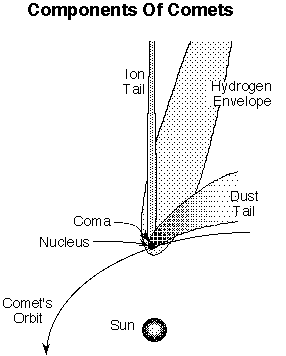
When a comet gets close enough to the Sun, it changes into something more spectacular. The picture above shows the parts of a comet that form when the cold "dirty iceberg" is warmed up by the Sun. This picture is courtesy of David Doody at JPL and is part of the Basics of Space Flight manual for all operations personnel.
When a comet nears the Sun around the Jupiter-Saturn distance, it warms up. The ices sublime---they change from solid to gas without going through a liquid phase (like the white mist coming from a block of frozen carbon dioxide, "dry ice"). Jets of material will shoot out from the nucleus. These jets can alter the comet's orbit (remember Newton's third law of motion?)
Since the orbit of Halley's Comet is known so well, spacecraft were sent to it when it passed through our part of the solar system in 1986. Here is a close-up of Halley's Comet. The spacecraft Giotto launched by the European Space Agency on July 2, 1985 reached Halley's Comet on March 13, 1986 and snapped this photo from 25,660 kilometers (15,950 miles) away. It got to within 596 kilometers (370 miles) of the nucleus, passing by at 68 kilometers/second. The nucleus of Halley's Comet has dimensions of 8×8×16 kilometers. The nucleus has a density of only 0.1 to 0.25 times the density of water and is very dark---it reflects only 4% of the sunlight (coal reflects about 6%). The density is about that of a loosely-compacted snowball and it is quite fragile---you could break a piece of the nucleus in two with your bare hands!

Selecting the picture will take you to the Max Planck Institut für Aeronomie from where this image Halley's nucleus came (will display in another window). The bright white jets on the left side of the nucleus are pointed in the direction of the Sun. Comet Hale-Bopp's nucleus is larger than Halley's nucleus---10 to 40 kilometers in size (about twice the size of Halley's Comet's nucleus) and is dust-rich. It began ejecting material when still at the distance of the outer planets, so it was discovered while still a couple of years from its perihelion passage in March of 1997. Comet Hyakutake (bright comet of spring 1996 that passed within 0.1 A.U. of the Earth) has a nucleus 1 to 3 kilometers in size. Four other comet nuclei that have been imaged up close by spacecraft are shown below: Comet Borrelly (about 8 km long) on the top left, Comet Wild (about 5 km in diameter) on the top right, Comet Tempel 1 (about 7.6 km x 4.9 km) before (bottom left) and after (bottom right) it got hit by the Deep Impact probe in July 2005 and Comet Hartley 2 (about 2.0 km x 0.8 km). Like Halley they too are very dark.
The Deep Impact mission was designed to investigate the interior of a comet by crashing a 370-kg copper impactor into the nucleus of Tempel 1 and analyzing the material shot out from the impact (copper is an element not expected to be in comets). Tempel 1 is made of a mixture of materials with high and low melting temperatures which tells us that the early solar nebula was more complex than previously thought. It has silicates like beach sand with olivine and peroxine that would have come from the inner solar system, carbonates and sulfide that would have come from part of the solar system further out, and ice (mostly water ice and a little carbon dioxide) from the outer solar system. Tempel 1 has a powdery surface layer a few tens of meters thick with most of the ices missing in that surface layer ("a marshmallow dipped in powered sugar"). There are a few smooth patches of water ice on the surface. Young surfaces right next to old, battered areas with a layered (slabs of ice) interior filled with pockets of empty space tell us the geological history of comets is more complex (and interesting!) than we initially thought.
The Deep Impact spacecraft has been renamed the EPOXI mission. It flew by comet Hartley 2 on November 4, 2010. Hartley 2 is about a quarter the size of Tempel 1. Its two ends are rough and knobbly from which spew jets of carbon dioxide ("dry ice") and a smooth region between the two ends from which frozen water sublimates through the dust. The images were clear enough that astronomers could see jets spewing out from specific surface features and even the "snow" particles in the jets the size of golf balls to basketballs. This is the first comet for which frozen carbon dioxide has provided the jets---usually the jets are made from the sublimation of frozen water. Select the images to go to the websites from where these images came (both images courtesy of NASA/JPL/UMD). The last image in the set compares the sizes of all five of the comet nuclei that have been visited by spacecraft (as of 2010).
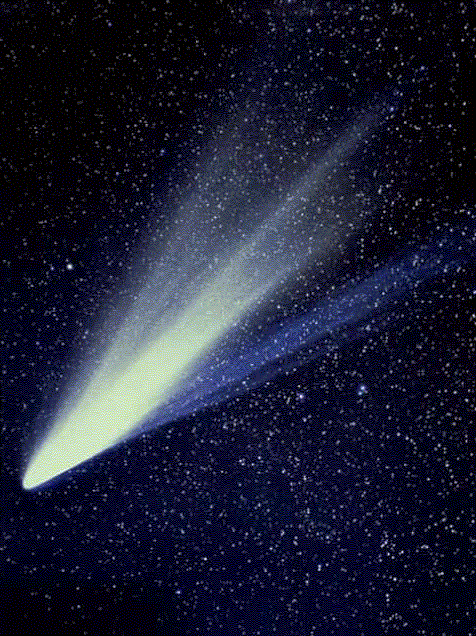
The Sun is constantly spewing out charged particles, called the solar wind, into the solar system. The solar wind travels along solar magnetic field lines extending radially outward from the Sun. Ultraviolet light from the Sun ionizes some of the gases in the coma. These charged particles (ions) are forced along magnetic field lines to form the ion tail millions of kilometers long. The blue ion tail acts like a "solar" wind sock. The ion tail always points directly away from the Sun, so when the comet is moving away from the Sun, its ion tail will be almost in front of it! The blue color is mostly from the light emitted by carbon monoxide ions but other types of ions also contribute to the light. Since the gas is so diffuse, the observed spectrum is an emission-line spectrum.
The dust tails forms from the solar photons colliding with the dust in the coma. The dust forms a long, curved tail that lies slightly farther our from the Sun than the nucleus' orbit. The dust tail has a yellow-white color from reflected sunlight. Both of the tails will stretch for millions of kilometers. Because of the large amount of dust, Hale-Bopp's tail was much brighter and whitish-yellow from reflected sunlight. Hyakutake's tail was dimmer and blue-green in appearance because of the low amount of dust and proportionally more ions.
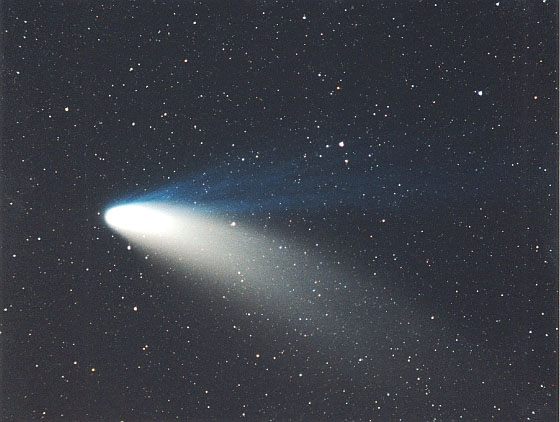
Comet Hale-Bopp was a spectacular comet in the spring 1997 sky. Courtesy of Darren Bly
![]() Go back to previous section --
Go back to previous section --
![]() Go to next section
Go to next section
last updated: January 5, 2011